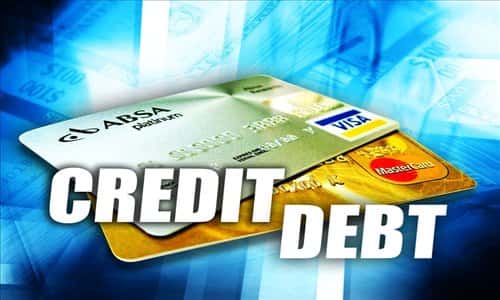Fed Warning: The U.S. Consumer Is Sick
 By The Daily Sheeple August 17, 2017
Share this article:
By The Daily Sheeple August 17, 2017
Share this article:
After we first reported last week that US credit card debt hit a
new all time high with both student and auto loans rising to fresh
records with every new report...

...
it won't come as a surprise that according to the just released latest
quarterly household debt and credit report by the NY Fed, Americans'
debt rose to a new record high in the second quarter on the back of an
increase in every form of debt: from mortgage, to auto, student and
credit card debt.
Aggregate household debt
increased for the 12th consecutive quarter, and are now $164 billion
higher than the previous peak of $12.68 trillion set in Q3, 2008.
As of June 30, 2017, total household indebtedness was
$12.84 trillion, or 69% of US GDP: a $114 billion (0.9%) increase from
the first quarter of 2017 and up $552 billion from a year ago. Overall
household debt is now 15.1% above the Q2 2013 trough.

Mortgage
balances, the largest component of household debt, increased again
during the first quarter to $8.69 trillion, an increase of $64 billion
from the first quarter of 2017. Balances on home equity lines of credit
(HELOC) were roughly flat, and now stand at $452 billion. Non-housing
balances were up in the second quarter.
Auto loans grew by $23 billion and credit card balances increased by $20 billion, while student loan balances were roughly flat.
Confirming
the slowdown in mortgage activity, mortgage originations in Q2 declined
to $421 billion from $491 billion. Meanwhile, there were $148 billion
in auto loan originations in the second quarter of 2017, an uptick from
the first quarter and about the same as the very high level in the 2nd
quarter of 2016.
Auto loan balances increased
by $23 billion, continuing their 6-year trend. Auto loan delinquency
rates increased slightly, with 3.9% of auto loan balances 90 or more
days delinquent on June 30. The aggregate credit card limit rose for the
18h consecutive quarter, with a 1.6% increase.
Outstanding
student loan balances rose modestly, and stood at $1.34 trillion as of
June 30, 2017. The second quarter typically witnesses slow or no growth
in student loan balances due to the academic cycle. As discussed
previously, a perilously high 11.2% of aggregate student loan debt was
90+ days delinquent or in default in 2017 Q2.
In
a troubling development, the report noted that the distribution of the
credit scores of newly originating mortgage and auto loan borrowers
shifted downward somewhat, as the median score for originating borrowers
for auto loans dropped 8 points to 698, and the median origination
score for mortgages declined to 754.
For now
this credit score decline has not impacted the credit market: about
85,000 individuals had a new foreclosure notation added to their credit
reports in the second quarter as foreclosures remained low by historical
standards.
And while much of the report was in line with recent trends,
and the overall debt that was delinquent, at 4.8%, was on par with the
previous quarters, the NY Fed did issue a red flag warning over the
transitions of credit card balances into delinquency, which the New York
Fed said "ticked up notably."
Discussing the
troubling deterioration in credit card defaults, first pointed out here
in April, the New York Fed said that credit card balance flows into both
early and serious delinquencies increased from a year ago, describing
this as "a persistent upward movement not seen since 2009."
As
shown in the chart below, the transition into 30 and 90-Day
delinquencies has, over the past two quarters, surged to the highest
rate since the first quarter of 2013, suggesting something drastically
changed in the last three quarters when it comes to US consumer
behavior.

"While
relatively low, credit card delinquency flows climbed notably over the
past year," said Andrew Haughwout, senior vice president at the New York
Fed. "This is occurring within the context of loosening lending
standards, as borrowers with lower credit scores recover their ability
to access credit cards.
The current state of
credit card delinquency flows can be an early indicator of future trends
and we will closely monitor the degree to which this uptick is
predictive of further consumer distress."
That bolded statement, is the first official warning by
the Fed that the US consumer is sick, and the Fed has no way reasonable
explanation for this troubling jump in delinquencies. Timestamp it,
because this will certainly not the be the last time the Fed warns about
the dangerous consequences of all-time high credit card debt.
As
for the "further uptick in consumer distress", we are just guessing but
the fact that credit card defaults are jumping at a time when sales at
fast food and other restaurants have declined for 17 consecutive
quarters, and when $250 billion in US household savings was just
"revised" away, may all be connected.
Originally published at the Daily Sheeple - reposted with permission.

No comments:
Post a Comment